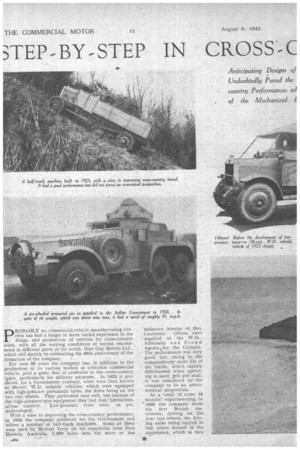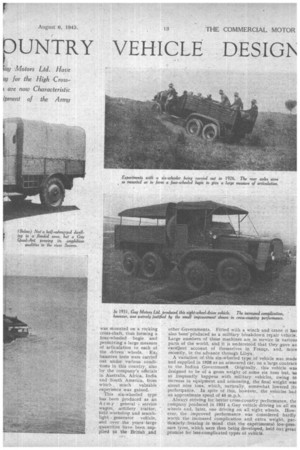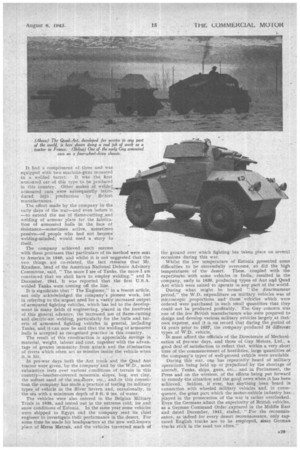STEP-BY-STEP IN CROSS-C pUNTRY VEHICLE DESIGN
Page 26

Page 27

Page 28

Page 31

If you've noticed an error in this article please click here to report it so we can fix it.
Anticipatory Designs of Undoubtedly Paced the country Performances wl of the Mechanized L
iay Motors Ltd. Have iy for the High Crossare now Characteristic ipment of the Army PROBABLY no commercial-vehicle manufacturing concern has had a longer or more varied experience in the design and production of vehicles for cross-country work, with all the varying conditions of terrain encountered in different parts of the world, than Guy Motors Ltd., which. will shortly be celebrating the 30th anniversary of the
formation of the company. ,,. .
For over 20 years the company has, in -addition to the production of its various models of orthodox commercial vehicle, paid.a great. deal of attention to the cross-country types, particularly for military purposes. In 1923 it produced, for a Government contract, what were then known as 30-cwt. W.D. subsidy vehicles, which were equipped _with. high-pressure pneumatic tyres, the drive being on the two rear wheels, They performed very well, but because of .the-high-pressure-tyre equipment they had their limitations, act-Oss country. Low-pressure tyres were, as yet, uncleveloped.
. . With a view to improving the cross-country performance, in 1925 the company produced for the Government and others a number of half-track machines, Some of these were used by Michael Terry on hiS expedition from Port Darwin, Australia, 1,200miles into the more -or less
-4.0.a
unknown interior of that Continent. Others were supplied to. the Admiralty and Crown Agents, for the Colonies. The performance was very good, but, owing to the comparatively short life of the tracks, which rapidly deteriorated u-hen operating in sand, grit and mud, it was considered b)-\ the company to be an uneconomical proposition.
As a result of some 18 months' experimenting, in ' 1926 the company made the first British sixwheeler, driving on the four rear wheels, the driving axles being carried in ball joints housed in the suspension, which. in turn
•
was mounted on a rocking cross-shaft, thus forming a four-wheeled bogie and permitting a large measure of articulation to each of the driven' wheels. Ex-; haustive tests were carried out under various conditions in this country, also by the company's officials in Australia, Africa, India and .South America, from which , much valuable experience was gained.
This six-wheeled type has been produced as an Army general service wagon, -artillery tractor, field workshop and search light generator vehicle, • and over the years large quantities have been supplied to the British and
other Governments. Fitted with a winch and crane it has also been-produced as a military bi-eakdown repair vehicle. Large numbers of these machines are in service in various parts of the world, and it is understood that they .gave an excellent account of themselves in France, and, more recently, in the advance through Libya.
A variation of. this six-wheeled type of vehicle was made 'and supplied in 1928 as an armoured car, on a large contract to the Indian Government. Originally, this vehicle was designed to be of a gross weight of some six tons but, -as so frequently happens with military vehicles, owing to increase in equipment and armouring, the final weight was about nine tons, which, naturally, somewhat lowered its perforwance. In spite of this, howevei, the vehicles had an approximate speed of 45 m.p.h.
Always striving for better cross-country performance, the company produced in 1931 a Guy vehicle driving On all six wheels and, later, one driving on all eight wheels. However, the improved performance was considered hardly worth the increased complication and extra weight, particularly bearing in mind that the experimental low-pressure tyres, which were then being developed, held out great promise for less-complicated types of vehicle. As a result of many experiments and much research with )ur-wheeled vehicles (two wheels driving) equipped with m-pressure tyres of increasingly large sections, in 1936 he company' adapted its then well-known Wolf and Vixen ummercial vehicles to form the basis of a military truck the W.D. specification.
The major units—engine, clutch, gearbox, axles 'Ind leering—were identical with their commercial types the )ain differences being the larger section of low-pressure yres . and the much shorter wheelbase, giving a small urning circle and high belly clearance, at the same time ombining a low overall height—to which great importance 'as attached—and, with a special radiator and bonnet, xceptionally good forward vision for the driver.
These vehicles—known as Ants—after very exhaustive eats were found so satisfactory that large Government a-ders were placed for them as load carriers. They showed Teat possibilities as tractors if further improved adhesion letween the wheels and .ground could be obtained. At the equest of the W.D. the company investigated he design of a suitable tractor for military pur)oses, utili4ng, so far as possible, Guy standard :ommercial units.
The greatest problems to be solved in securing t good all-round cross-country performance are, if course, on the one hand, to obtain the equisite torque at the tyres to negotiate stiff uadients, whilst on the other hand, not having ;0 great a torque as to destroy the adhesion Rtween tyres and ground when the vehicle, in :he hands of an unskilled driver, is negotiating sag, loose sand or wet clay, the conditions of vhich vary enormously. Only varied experinice, under extreme conditions to be found in different parts of the world, such as the cornany possessed, could supply the answer, Normally, the coefficient of adhesion for rubber on hard road is, say, 0.6, and the torque going through the wheels must at no time exceed the weight of the vehicle combined with the :oefficient of adhesion, otherwise wheelspin is bound to occur. The difficulties that were experienced will be understood when it is remembered that the vehicle had to negotiate sand, slime and clay surfaces, the coefficient of adhe1on then being much lower. Before this problem 'could be solved it was necessary to make a series of tests to determine the actual adhesion factors on various surfaces.
The results of these experiments gave figures varying between very wide limits, some of which are not to be found in books of reference, and taking into account the effect of torque reaction on all-four wheels, on a four-wheel-drive machine, it will be seen that a fine balance bad to be attained between the factors of adhesion,' individual wheel loading and the tractive effort being passed through each wheel.
The type of sPring suspension had also to he studied, whether the vehicle should be independently sprung or the A26
more orthodox semi-elliptic type used. The relatiVe merits of each had to be carefully considered, e.g., the result and effect of wheel articulation on ground clearance and spring periodicity in relation to torque reaction: at the same time due consideration had to be given to the importance of reducing the number of -working parts for ease, of maintenance in the Field.
These questions were explored. Semi-elliptic springs of the progressive type were designed which gave all the articulation required, and at the end of 1937 a vehicle similar to the " Ant" but driven on all four wheels was produced. It was christened the " Quad Ant." It was an immediate success, and since that date has been one of the W.D. Field Artillery tractors.
A variation of this type, in which the engine was mounted at the rear of the frame and the driver sat in the normal forward position, produced a first-class armoured car, the body of which was the first British .type with all-welded construction.
It had a complement of three and was equipped with two machine-guns mounted in a welded turret. It was the first 'armoured car of this type to be produced in this country. Other makes of welded armoured cars were subsequently introduced into production by British manufacturers.
The effort made by the company in the early days of the war—and even before it —to extend the use of flame-cutting and welding of armour plate for the „fabrication of armoured hulls in the face of resistance—sometimes active, sometimes passive—of people who had not beeome welding-minded, would need a story to itself.
The company achieved such success
with these processes that particulars of its method were sent to America in 1940, and whilst it is not Suggested that the two things are co-related, the fact remains. that Mr. Knudsen, head of the American National Defence Advisory Committee, said, " The more I see of Tanks, the more I am convinced that we shall have to employ welding," and in December, 1941, It was reported that the first U.S.A. welded Tanks were coming off the line. ,
It is significant that " The Engineer," in a teeent article, not only acknowledged the company's pioneer work, but in referring to the urgent need for a vastly increased output of armoured fighting vehicles, which has led tO the development in many fields of engineering, placed in the forefront of this general advance, the increased use of flame-cutting and electric-arc welding, particularly for the hulls and turrets of armoured fighting vehictes in general, including Tanks, and it can now be said that the welding of armoured hulls is accepted as recognized practice in this country.
The result of this construction is appreciable savings in material, weight, labour and cost, together with the advantage of greater immunity from attack and the elimination of rivets which often act as missiles inside. the vehicle when it-, is hit.
• In pre-war days both the Ant truck and the Quad Ant tractor were given, by the company and by the W.D., most exhaustive tests over various conditions of terrain in this country—heather-covered mountain slopes, bog, wet clay, the softest sand of the sea-More, etc., and-in this connee.' tion the company has made a practice of testing its military types of vehicle in the River Severn and, occasionally, in the sea with a minimum depth of 3 ft. 6 ins, of water.
The vehicles were also entered in the Belgian Military Trials in 1938, and tested out in the extreme cold, ioe and snow conditions of Estonia. In the same year some vehicles were shipped to Egypt and the company sent its chief engineer to investigate their performance in the desert. For some time he made his headquarters at the now well-known place of Mersa Matruh, and the vehicles traversed much of the ground over which fighting has taken place on several occasions during this war.
Whilst the low temperature of Estonia presented some difficulties to be successfully overcome, so did the high temperatures of the desert. These, • coupled with the experieric'es with some vehicles in India, resulted in the company, early in 1939, producing types of Ant and Quad Ant which were suited to operate in any part of the world.
During what might be termed " the disarmament period," the W.D. expenditure on military vehicles was of microscopic ,proportions andthose vehicles which were ordered Were purchased in such small quantities that they could not be produced profitably. The Guy concern was one of the few British manufacturers who were prepared to design and develop various military vehicles largely at thei: own expense, and it is on record that during the period of 14 years prior to 1937, the company produced 24 different types of W.D. vehicle. It must afford the officials of the Directorate of Mechanization of pre-war days, and those of Guy Motors, Ltd., a good deal of satisfaction to reflect that, within a very short time of the commencement of hostilities, large quantities of the company's types' of well-proved vehicle were available.
During this war, one has repeatedly heard of military operations being held up or prejudiced by the shortage of aircraft, Tanks, ships, guns, etc., and in Parliament, the Press and on the wireless, of the efforts being put forward to remedy-the situation and the good news when it has been achieved. Seldom, if ever, has anything been heard in connection with wheeled military vehicles and, in consequence, the great part which the motor-vehicle industry has played in the prosecution of the war is rather overlooked. Even the Germans admit the superiority of British vehicles, as a German Command Order captured in the Middle East and dated December, 1941, stated, " For the reconnaissance, as -indeed for every desert reconnaissance, only captured English trucks are to be employed, since German trucks stick in the sand too often."




















































